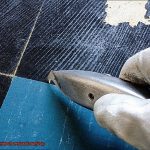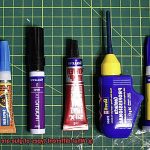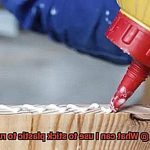When our precious carpets bear the brunt of spills and stains, frustration sets in. But perhaps nothing is more exasperating than a stubborn glue mark. Whether it’s the aftermath of a failed DIY project or an unintentional spill, removing glue from carpet can feel like an impossible feat.
In this guide, we’ll delve into the world of glue removal and uncover the most effective methods to dissolve that sticky mess from your beloved carpet fibers.
To successfully bid farewell to glue stains on carpets, it’s crucial to understand their root causes.
Glue can infiltrate your carpets during crafty endeavors, home makeovers, or even when trying to mend loose carpet fibers.
It may also sneakily escape its container while you’re busy with repairs or installing new flooring. No matter how it got there, that resulting sticky nightmare can quickly become a headache if not dealt with promptly and correctly.
So let’s embark on a journey to discover the ultimate solutions for dissolving glue from your carpet and restoring its former glory.
Different Types of Glue Found on Carpets
Contents
- 1 Different Types of Glue Found on Carpets
- 2 Dissolving Adhesive Glue from Carpet
- 3 Removing Super Glue from Carpet
- 4 Dissolving Water-Based Glues from Carpet
- 5 Tips for Using Solvents to Dissolve Glue From Carpets
- 6 Alternatives to Solvents for Removing Glue From Carpets
- 7 When to Seek Professional Help For Removing Stains and Glue From Carpets
- 8 Conclusion
Finding glue stains on your carpet can be a sticky situation, but fear not. With the right knowledge and techniques, you can bid adieu to those unsightly marks. In this article, we will explore the different types of glue commonly found on carpets and how to effectively remove them. Let’s dive in.
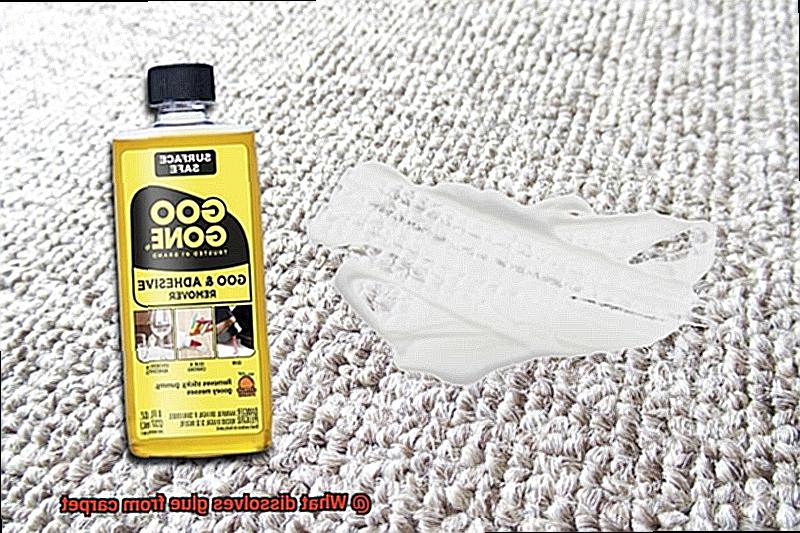
Water-Based Glue:
Water-based glues are often used for carpet installation or securing loose edges. These glues contain polymers dissolved in water, making them easier to clean up when wet. However, if water-based glue dries on the carpet, it can become more challenging to remove.
To tackle this type of glue, start by dampening a clean cloth with warm soapy water. Gently dab at the glue until it starts to loosen. Avoid saturating the carpet with excessive moisture to prevent mold or mildew growth.
Solvent-Based Glue:
Solvent-based glues are commonly used for heavy-duty applications like securing carpet seams or padding. These glues contain volatile organic compounds (VOCs) and do not dissolve easily in water.
To remove solvent-based glue, test a solvent or adhesive remover on a small area before applying it to the glue stain. Gently blot the affected area with a clean cloth soaked in the solvent until the glue starts to dissolve.
Hot Melt Adhesive:
Hot melt adhesive, also known as hot glue, is a thermoplastic adhesive that becomes solid when cooled down. Accidental spills or improper usage of hot glue guns can leave behind hot melt adhesive on carpets.
Soften and remove hot melt adhesive by applying heat again. Use a warm iron or hairdryer to melt the glue, then blot it away with a clean cloth.
Carpet Adhesives:
Carpet adhesives come in different forms and are specifically designed for attaching carpets to various surfaces. These adhesives include pressure-sensitive, dry-set, or wet-set options. Follow the manufacturer’s instructions for removal, as different carpet adhesives may require specific techniques or solvents.
It is important to choose the appropriate adhesive remover or solvent based on the type of carpet adhesive used.
Construction Adhesives:
Construction adhesives are heavy-duty glues used in construction or renovation projects that can find their way onto carpets. Removing construction adhesive may require specialized solvents or techniques. Consult a professional or follow the manufacturer’s instructions for safe removal. Take extra care when dealing with construction adhesives, as they are designed for strong bonding and can be more difficult to remove.
Removing different types of glue from carpets can be a daunting task, but armed with the right information, you can tackle it like a pro. Remember to identify the type of glue before attempting removal and test any solvents on an inconspicuous area first. Take it slow, be patient, and follow the recommended techniques for each type of glue.
Dissolving Adhesive Glue from Carpet
Glue stains on your carpet can be a real eyesore, but fear not. With the right knowledge and techniques, you can bid those stubborn adhesive glue marks farewell. As an expert in the field, I’m here to guide you through the process of dissolving adhesive glue from carpet.
Before we dive into the methods, let’s understand the different types of glue commonly found on carpets. Some of the most common culprits include:
- Super Glue: This fast-drying adhesive can cause headaches when it comes into contact with your carpet fibers.
- Carpet Glue: Used during carpet installation, this glue can leave behind unsightly residue if not properly cleaned.
- Craft Glue: Whether it’s for DIY projects or accidental spills, craft glue can be a sticky situation to deal with.
Now that we know what we’re up against, let’s explore some effective techniques to dissolve adhesive glue from carpet:
- Solvent or Adhesive Remover: Start by testing a small area of the carpet with a solvent or adhesive remover specifically designed for this purpose. If there’s no damage or discoloration, proceed to apply the product directly to the affected area. Let it sit for the recommended time and then gently scrub or blot the glue away with a clean cloth or sponge.
- Heat It Up: For heat-resistant carpets, using a hairdryer on a low setting can help soften the adhesive glue, making it easier to remove. Be careful not to overheat the fibers.
- Warm Water and Dish Soap: Create a mixture of warm water and mild dish soap. The soap helps break down the adhesive while the warm water loosens it from the carpet fibers. Gently scrub or blot the area until the glue is fully dissolved.
- Persistence Pays Off: For stubborn or dried-on adhesive glue, you may need to repeat the process multiple times or try a combination of methods. Remember, patience and persistence are key.
Once you’ve successfully removed the adhesive glue, it’s essential to clean the affected area thoroughly. Use water and a mild detergent to remove any residue, and consider using a carpet cleaner or spot remover specifically designed for carpets to ensure the area is clean and fresh.
Allow the carpet to dry completely before using or walking on the area to prevent any potential damage or re-soiling.
Removing Super Glue from Carpet
Imagine the frustration of accidentally spilling or dropping super glue on your beautiful carpet. The worry sets in as you fear a permanent mark on your beloved flooring.
With the right techniques and a bit of patience, you can bid farewell to those stubborn glue stains and restore your carpet to its former glory.
Act Quickly:
To successfully remove super glue from carpet, quick action is crucial. The longer the glue sits on the fibers, the more challenging it becomes to remove. So, as soon as you notice a spill or drop, spring into action.
Test an Inconspicuous Area:
Before attempting any removal method, test a small, inconspicuous area of your carpet first. This step ensures that the solution or solvent you use won’t cause discoloration or damage.
Acetone or Nail Polish Remover:
One widely-used method for removing super glue from carpet involves acetone or nail polish remover. Dampen a clean cloth with a small amount of acetone and gently dab the affected area.
Avoid vigorous rubbing, which could spread the glue further into the carpet fibers. Repeat until the glue softens and loosens.
Warm Water and Dish Soap:
If you prefer a milder approach, try using a mixture of warm water and dish soap. Create a soapy solution by mixing a few drops of mild dish soap with warm water. Apply this solution to the affected area using a clean cloth or sponge, then gently blot. Repeat until the super glue dissolves.
Adhesive Removers:
For stubborn super glue stains, adhesive removers designed specifically for strong adhesives can be your secret weapon. These removers are readily available at hardware stores or online. Follow the manufacturer’s instructions carefully for safe and effective removal.
Proper Ventilation and Protection:
When working with solvents or adhesive removers, ensure proper ventilation and avoid inhaling fumes. Protect your skin by wearing gloves to prevent irritation or potential chemical reactions.
Clean Up:
After successfully removing the super glue from your carpet, clean the area with warm water and mild detergent to eliminate any residue from the cleaning process.
Consult a Professional:
If all else fails or if you’re unsure about the appropriate removal method for your specific carpet or super glue type, don’t hesitate to consult a professional carpet cleaner for expert assistance.
Dissolving Water-Based Glues from Carpet
Water-based glues are commonly used in various applications, including carpet installation, craft projects, and household repairs. While these glues are effective for their intended purposes, accidents can happen, and a blob of water-based glue may find its way onto your beautiful carpet.
I am here to share some wisdom on how to dissolve water-based glues from carpets and save the day.
Prevention is key when working with water-based glues near carpets. Take precautions to avoid spills or accidents by using protective coverings or working in a well-ventilated area. This helps minimize the chances of glue seeping into the carpet fibers and becoming a nightmare to remove.
Now, let’s get down to business. One of the easiest and most effective methods for dissolving water-based glues from carpets is using warm water and mild detergent. Simply mix a few drops of mild detergent with warm water in a bowl.
Dip a clean cloth or sponge into the soapy solution and gently dab the affected area. Avoid vigorous rubbing that might push the glue further into the carpet fibers. Keep blotting until you see that sticky mess starting to dissolve.
If the glue seems stubborn, it’s time to bring out the big guns – vinegar. Mix equal parts vinegar and warm water in a spray bottle and spritz it onto the glue stain. Let it sit for a few minutes to let the vinegar work its magic in breaking down the adhesive properties of the glue.
Then, grab your trusty cloth or sponge and blot away that dissolved glue. Rinse the carpet with plain water and blot again to remove any remaining residue.
But what if those stubborn glue stains just won’t budge? Fear not, my friend, for rubbing alcohol is here to save the day. Apply some rubbing alcohol onto a clean cloth and gently dab at the glue stain. The alcohol will help dissolve the glue, making it easier to remove. Just be cautious, as rubbing alcohol can potentially damage certain types of carpet fibers or cause discoloration.
Before you go on a cleaning spree on your entire carpet, it’s always a good idea to test any cleaning method on a small, inconspicuous area first. This way, you can ensure it won’t cause any adverse effects.
And if all else fails, don’t hesitate to call in the professionals. Carpet cleaning services have access to specialized solutions and equipment that can safely and efficiently dissolve and extract stubborn glue stains without causing damage to your beloved carpet.

Tips for Using Solvents to Dissolve Glue From Carpets
When glue spills on carpets, it can create a sticky and unsightly mess. However, with the right solvents and techniques, you can effectively dissolve the glue and restore the beauty of your carpet. In this blog post, we will explore some valuable tips for using solvents to remove glue from carpets. Let’s dive in.
Choose the Right Solvent:
Different types of glue require different solvents for effective removal. For adhesive glues, acetone or rubbing alcohol can do the trick. Acetone-based nail polish remover is particularly effective for super glue stains. For water-based glues like craft or school glue, warm water mixed with mild dish soap works wonders.
Test on a Small Area:
Before using any solvent on your carpet, it’s crucial to test it on a small, inconspicuous area first. This will help ensure that the solvent won’t cause any damage or discoloration to your carpet fibers.
Apply a small amount of the solvent to the test area and observe for any adverse reactions before proceeding further.
Apply the Solvent:
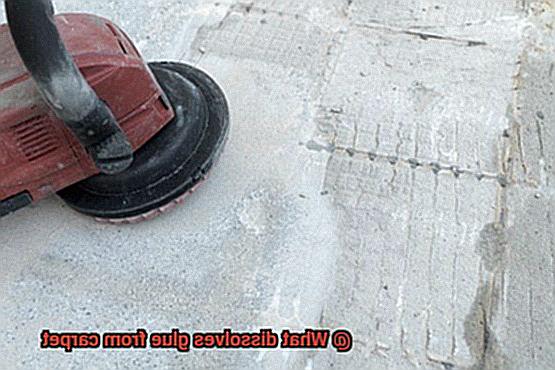
Once you’ve chosen the appropriate solvent, apply it directly to the affected area. Use a clean cloth or sponge to gently blot the area and allow the solvent to penetrate the glue. Be sure not to saturate the carpet; a little goes a long way. Allow the solvent to sit for a few minutes to soften the glue.
Scrape Away Softened Glue:
After letting the solvent sit for a few minutes, use a plastic scraper or blunt knife to gently scrape away the softened glue. Take care not to damage the carpet fibers while doing this. If necessary, you can also use your fingers to gently rub away any remaining residue.
Rinse and Repeat:
To ensure all residue is removed, rinse the area thoroughly with clean water after removing the glue. Blot the area dry with a clean towel or use a wet vacuum to extract excess water. If necessary, repeat the process until all traces of glue are gone. It’s important to remove all solvent residue to prevent any potential damage to the carpet fibers or adhesive backing.
Consider Professional Help:
If you’re dealing with stubborn or old glue stains that don’t respond to solvents, it may be best to seek professional assistance. Carpet cleaning professionals have the expertise and specialized tools to safely remove tough glue stains without causing any damage to your carpet.
Alternatives to Solvents for Removing Glue From Carpets
When it comes to removing glue from carpets, solvents may not always be the best option. Fortunately, there are several effective alternatives that are gentler on your carpet fibers. Let’s explore these methods in more detail.
- Heat: One popular alternative involves using heat to soften the glue. Start by placing a damp cloth over the glue and then gently heat the area with a hot iron. The heat will cause the glue to soften, making it easier to remove. Remember to use a low heat setting and keep the iron moving to avoid damaging your carpet.
- Vinegar or Lemon Juice: If you prefer natural ingredients, vinegar or lemon juice can work wonders. These acidic substances help break down the glue, making it easier to remove. Simply apply them directly to the glue, let them sit for a few minutes, and then wipe away with a clean cloth.
- Baking Soda: Another fantastic alternative is baking soda. Sprinkle it over the glue, gently rub it into the carpet fibers, and let it sit for a few minutes. Then, vacuum up the baking soda along with the softened glue – it’s that simple.
- Dish Soap and Warm Water: For stubborn glue stains, try using a mixture of dish soap and warm water. Apply the soapy water to the glue and gently scrub with a soft-bristle brush. Rinse with clean water and blot dry – voila.
Remember to always test any alternative method on a small inconspicuous area first to ensure it doesn’t cause any damage or discoloration. And when removing glue from carpets, blot rather than rub to prevent spreading or pushing the glue further into the fibers.
When to Seek Professional Help For Removing Stains and Glue From Carpets
Stains and glue on carpets can be a nightmare to deal with. Sometimes, no matter how hard you try, those stubborn marks just won’t budge. That’s when it’s time to call in the professionals. But how do you know when it’s the right time? Let’s take a closer look at when seeking professional help is your best bet.
- Old and set-in stains: Time can be a ruthless enemy when it comes to stains. You’ve tried everything – scrubbing, scraping, even pleading with the carpet gods – but that stain remains steadfast. Don’t despair. Professional carpet cleaners have the tools and expertise to tackle those deep-set stains that seem impossible to remove.
- Tough, dried glue: Glue that has hardened onto your carpet is a whole other level of frustration. It’s like a sticky fortress that refuses to surrender. Attempting to scrape it off yourself is a risky move that could damage your carpet even further. Leave it to the pros who have the specialized techniques and equipment to safely remove dried glue without causing any harm.
- DIY methods have failed: We all love a good do-it-yourself solution, but sometimes they just don’t cut it. You’ve tried every hack and remedy you could find, but that stain or glue is still mocking you from the depths of your carpet fibers. It’s time to admit defeat and bring in the experts who have an arsenal of cleaning agents and methods at their disposal.
- Unknown stain or glue type: Not all stains and glues are created equal. Using the wrong cleaning agents or techniques can turn a simple problem into a catastrophic carpet disaster. Professional cleaners are trained to identify different types of stains and glues and use the appropriate methods to safely remove them, saving you from any accidental damage caused by guesswork.
- Time-saving and longevity: Let’s face it – removing stains and glue from carpets is no walk in the park. It’s a time-consuming and labor-intensive task that can drain your energy and patience. By hiring professionals, you can save yourself the hassle and let them work their magic while you focus on more important things in life. Plus, their gentle yet effective cleaning methods can help prolong the life of your carpets, keeping them beautiful for years to come.
GIBmi1ZVUtQ” >
Also Read: How To Remove Glue On Carpet?
Conclusion
When it comes to removing glue from your carpet, there are a few effective solutions that can come to your rescue.
One option is using rubbing alcohol, which works wonders in dissolving the stubborn adhesive. Another solution is white vinegar, a versatile household item that can break down the glue and make it easier to remove.
Additionally, you can try using warm soapy water to loosen the grip of the glue on your carpet fibers. For more stubborn stains, a mixture of baking soda and water can be applied as a paste and left to sit before scrubbing away the residue.
Remember to always test these solutions in an inconspicuous area first and proceed with caution.


